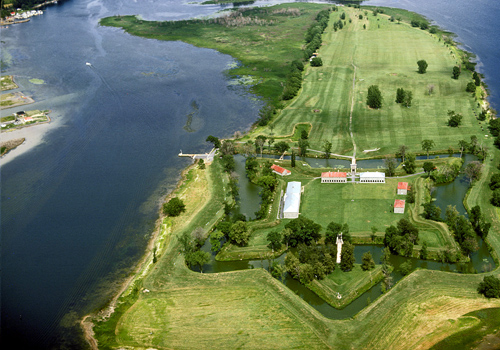Other Name(s)
Fort Lennox, West Front casemates
Casemates - West
Casemates du front ouest
Links and documents
Construction Date(s)
1822/01/01
Listed on the Canadian Register:
2005/09/22
 Statement of Significance
Statement of Significance
Description of Historic Place
The West Front casemates at Fort Lennox form an enfilade of 11 vaulted spaces built into the fort embankment and faced with similar ashlar stone façades. They are composed of seven identical units, each equipped with only one door, and of four later casemates to the south of this series, each with a central door flanked by two windows. The alignment is dominated at both ends by stone stairs leading up to the rampart terre-plein. The West Front casemates are located behind the barracks to which they are closely related. The designation is confined to the footprint of the building.
Heritage Value
The West Front casemates at Fort Lennox are a Recognized Federal Heritage Building because of their historical associations, and their architectural and environmental values.
Historical value:
The West Front casemates at Fort Lennox are closely associated with the established defensive strategy for Canada’s borders between 1820 and 1830. In the wake of the War of 1812-1814, the British military authorities reviewed their defensive strategy for warding off attacks from the south, by way of Lake Champlain and the Richelieu River, and decided to build a new fortification at Ile-aux-Noix. The fort and its buildings thus also illustrate the strategic and tactical discussions that influenced the development of the Haut-Richelieu Valley. The West Front casemates were erected as an integral component of the fort and form part of the storage and services infrastructure built within the ramparts.
Architectural value:
Attributed to Samuel Romilly, commanding officer of the Royal Engineers, the West Front casemates at Fort Lennox are good, typical examples of military engineering of the period, which made use of the rampart embankment to erect bomb-proof vaulted structures. Good quality materials and craftsmanship were used, with the intent of making these structures long lasting and resistant.
Environmental value:
The West Front casemates at Fort Lennox create the effect of a succession of apertures under the ramparts and reinforce the military character of the fort. The site and its relationship to the scenic country setting of Ile-aux-Noix has remained unchanged. Through the somewhat mysterious quality of their underground vaults, the casemates reinforce the traditional imagery of old fortifications, popular with visitors to the site, and help make them a familiar landmark of the area.
Sources:
André Charbonneau, Les casemates du fort Lennox, Québec. Federal Heritage Buildings Review Office Report 89-57; Officers’ Quarters – Casemates of the North and West Fronts, Saint-Paul-de-l’Ile-aux-Noix, Québec, Heritage Character Statement, 89-57.
Character-Defining Elements
The character-defining elements of the West Front casemates at Fort Lennox should be respected.
The structure’s efficient functional design, typical of engineering works of the period, and its good quality materials and craftamanship, as manifested in:
-the simple massing and logical form of the casemates, which create a regular succession of bays set into the fort ramparts;
-the bomb-proof elliptical masonry vault of each unit;
-the simple, unadorned stone façade, each with a simple single door opening or with a door flanked by two side windows (in the case of the four later units);
-elements such as the fireplaces, bread oven and the hand-basins which are associated with the former use of the four later casemates as soldiers’ kitchens.
The manner in which the building reinforces the military character of its setting and serves as a local landmark, as demonstrated in:
-the siting of these underground spaces in the embankment of the fort ramparts;
-the intact quality of the landscape in and around the fortifications, which has remained free of more recent constructions.
 Recognition
Recognition
Jurisdiction
Federal
Recognition Authority
Government of Canada
Recognition Statute
Treasury Board Heritage Buildings Policy
Recognition Type
Recognized Federal Heritage Building
Recognition Date
1989/12/07
 Historical Information
Historical Information
Significant Date(s)
1824/01/01 to 1824/01/01
Theme - Category and Type
Function - Category and Type
Current
Historic
- Defence
- Military Defence Installation
Architect / Designer
Attributed to Samuel Romilly, commanding officer of the Royal Engineers
Builder
n/a
 Additional Information
Additional Information
Location of Supporting Documentation
National Historic Sites Directorate, Documentation Centre, 5th Floor, Room 89, 25 Eddy Street, Gatineau, Quebec
Cross-Reference to Collection
Fed/Prov/Terr Identifier
3725
Status
Published
Related Places

Fort Lennox National Historic Site of Canada
Fort Lennox National Historic Site of Canada is a highly evocative military fortification and landscape covering the full extent of Île aux Noix in the Richelieu River near the…